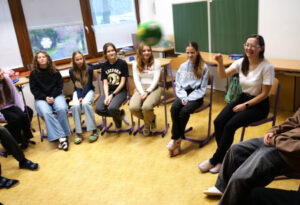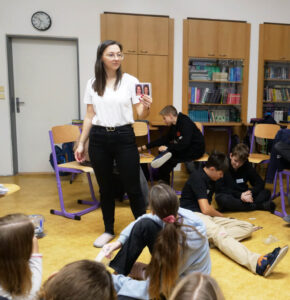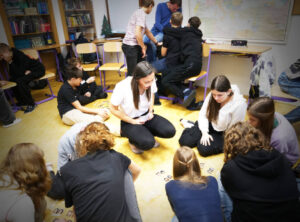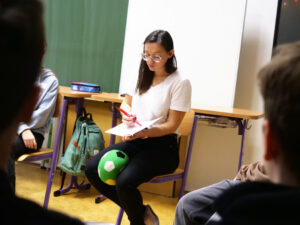Having everything under control – Katerina cannot guarantee that with her program. But what she could do was very pleasant and encouraging: for two hours she became part of a group of teenagers and could speak to them from the heart and soul, which was very rare. Together they discussed what addiction is and how to resist it.
I had the privilege of attending a program led by the Healthy Youth Worker Katerina Plachtova on the topic Do I have it under control?. For two lessons she discussed addictions and how to avoid them with these eighth-grade students.
She started with an introduction and setting the necessary class rules that guarantee more freedom and space for discussion in such programs, but at the same time make sure that the whole meeting does not degenerate into arguing and parallel conversations. Katerina solved this with a plush ball, without holding it no one could enter the debate.

Katerina is giving the word to the pupils. This is done simply by throwing the plush ball to whoever wants to say something.
Katerina opened the discussion with a simple question: “What could I not live without?” And the basic necessities for living, such as air or water, weren’t meant here. The students started to list: books, music, friends, chocolate… These superfluous things become a kind of prefigurement of what substance addiction looks like.
And here Katerina naturally moved on to a list of substances that are commonly known to be health and life threatening. But then she reminds us that the central theme is not these substances, but our relating to them.
The program moves on to various experiential tasks which the eighth-graders complete in small groups. For example, a very interesting task is when the group has to match different pairs of photos of the same person: one of the photos shows the person before addiction and the other one shows the person at different stages of addiction.
The group also has to guess how much time has passed between the first and second photo. The students can see, and then discuss, what changes in that person’s body and soul in the process leading to complete addiction.
Katerina adds a bit of theory here, drawing the classic addiction curve for the students, as a person experiences it emotionally in the context of increasing resistance to the addictive substance and increasing need to up the dose to at least feel a bit ‘normal’.

What did the man or woman look like before falling into addiction? How did the addiction change him or her? How much time did it take? Katerina discusses all this with the class.
The program continues with various stories and specific effects of the most common substance addictions on the human body: such as cigarettes, marijuana and alcohol. Katerina knows how to work with the motivation of the teenagers and the dynamics of the discussion to make it interesting, so the program goes by very quickly.
The eighth-graders could hear some important information in the way that is acceptable and interesting to them. They became co-creators of the program themselves. And this is a prerequisite for this information not to just pass by them unnoticed, but to settle in their minds and hearts so that they can act on it themselve.
Martin Stavjanik, the Authorized Supervisor of the HY Program workers







